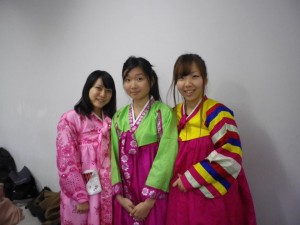Playing with the Kyoto University Frisbee team (Breeze) has been quite the experience, and it’s definitely taught me about the seriousness with which students in Japan take their circles. (If this isn’t enough proof, my host brother also sacrifices a lot of his life to his kendo club).
On a cold, rainy day when my host mother thought there wouldn’t be practice everyone was there, wearing their normal gear, no raincoats at all. On Saturdays, when there are no classes and no homework, practices can go for 4, even 5 hours (though I’ve only stayed 4 hours once). When a member of the women’s team couldn’t make it to a practice, she had to apologize and explain profusely why she couldn’t be there. They take the team very seriously.
But – it pays off. The men’s team is pretty high up in national rankings and I believe the women’s team is in the top 10 of the region. I haven’t been able to go to any tournaments because I’m not officially a member, but I’ve heard of their amazing feats and seen (and been overshadowed by) their skills.
I think I made the mistake of having very high expectations going into the club, which led to some frustration that actually, looking back, was unjustly felt. I expected the team to let me become a member – I didn’t even realize being a non-member was a possibility – and I expected them to talk to me, or at least ask me what my intentions were in showing up every week.
In the end, I realized that as the foreigner sitting in on a Japanese students’ frisbee practice, it is my duty to be interested, social, and the most ganbatte-iru person there. I also failed to consider, for the first few weeks, that this team is very competitive and only accepts as members those who can pour their free time and social life into the team. Unfortunately, by missing one practice a week for class and missing a few others for travel, I was already not member-material.
From my current perspective, I’m very grateful that the team has been so inclusive of me – letting me join entire practices, giving me slowed-down explanations of the drills we were running, occasionally asking me questions about Japan or the U.S., and most-impressively taking very good care of me when I sprained my ankle (two teammates piggy-backed me to a water spout and their trainer came to wrap it up!). The team has warmed up to me more and more and I’m really glad they’ve put up with my not-so-competitive Frisbee skills.
I have to admit that my role on the team is still somewhat imbalanced by my comparatively low frisbee and Japanese skills, so it can be kind of stressful and at times I feel like I’m a liability. Perhaps the most prominent thing that I have and they don’t – knowledge of English and America – will shine through at some point, and I’m dearly hoping for that day. Until then, I’ll keep trying my best – gaining skill, proving I know some Japanese, and making some friends! By the beginning of next semester, if I do really feel like a liability on the field, I think I’ll try to find a less-competitive team or even a different kind of CIP. Before I make any big decisions, though, I’m up for giving this CIP a few more shots at success.
Regardless of how things end up, I’m glad I spent this semester practicing with Breeze. It gave me a good time and a much-needed culture shock.

